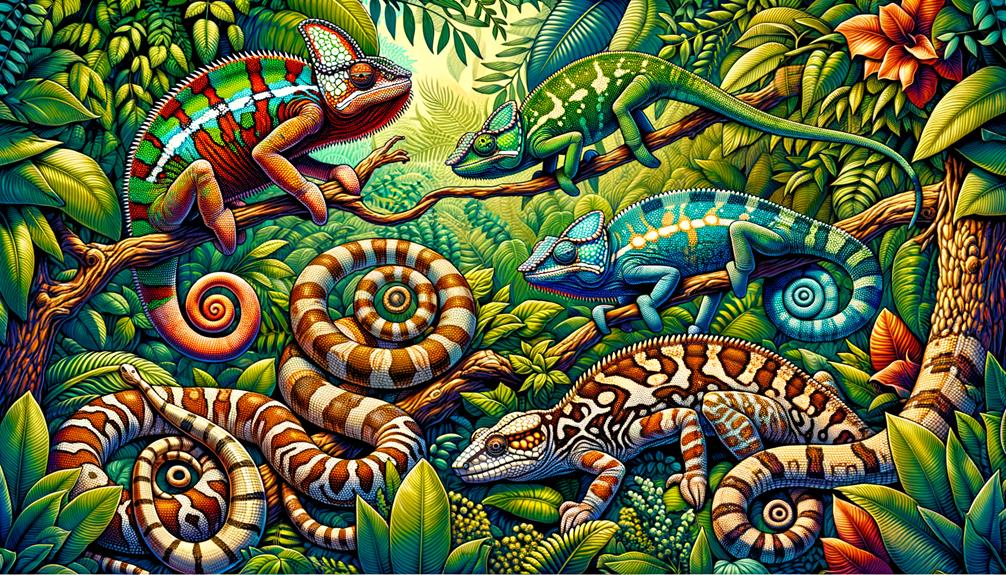When I explored reptilian parental care behaviors, I found some fascinating methods that have evolved to ensure their offspring's survival. Crocodiles and king cobras, for instance, build intricate nests to control incubation temperatures. Some species, like pythons and skinks, take it a step further by guarding their eggs to maintain ideal conditions. Crocodilian parents even help their hatchlings by digging up the nests and safely transporting them to water. Live-bearing in squamates, a group of reptiles, also enhances offspring survival through direct nourishment and protection. These diverse behaviors showcase the remarkable adaptations that have developed to balance reproductive investment with offspring survival. If you're interested in learning more, there's a rich array of intricate behaviors to uncover in this field.
Key Takeaways
Crocodiles take care of their eggs by building and defending nest mounds, which helps regulate temperature and keep predators away.
King cobras go to great lengths to ensure their eggs incubate safely by building nests and standing guard over them.
Female pythons wrap their bodies around their eggs and use muscle vibrations to keep the nest at the right temperature.
When their babies hatch, crocodilian parents lend a helping hand by digging them out of their nests, carrying them to water, and providing body warmth.
Some lizards, called squamates, give birth to live young, which means their babies get protection and nutrients directly from them, giving them a better chance of survival.
Nest Building
While observing reptilian species, I've noticed that nest building is a critical behavior that ensures ideal conditions for egg incubation and ultimately, the survival of their offspring. For instance, crocodiles meticulously construct ground nests using a mix of foliage, mud, and twigs. This composite structure forms a nest mound that provides optimal conditions for egg deposition. The materials used play a crucial role in temperature control, which is vital for successful incubation.
King cobras also exhibit fascinating nest-building behaviors, crafting nests on the forest floor. These nests are intricately designed to safeguard the eggs and provide suitable incubation conditions. Similarly, terrapins prefer river banks for their nests, where they lay and incubate their eggs. The strategic location of these nests aids in maintaining the necessary temperature for egg development.
Sea turtles take temperature control to another level. By regulating the temperature within their nest mounds, they guarantee proper development of their offspring. This precise temperature control not only affects incubation but also directly influences sex determination of the hatchlings. The intricate nest-building behaviors across these species highlight the vital role of environmental manipulation in reproductive success.
Egg Guarding
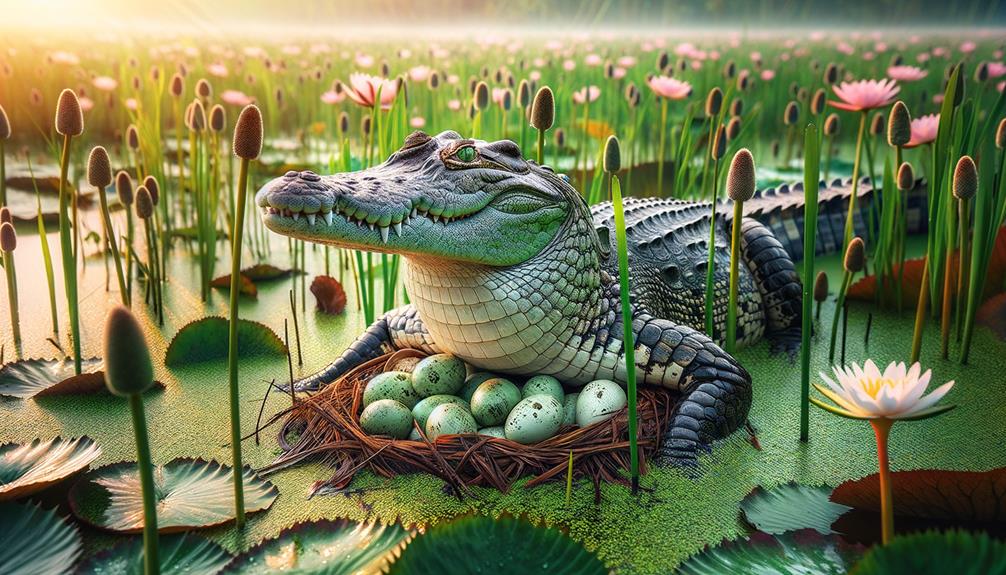
Egg guarding in reptiles is a fascinating phenomenon where parents go to great lengths to protect and nurture their developing offspring. Female pythons, for instance, coil around their eggs and vibrate their muscles to incubate them, which not only safeguards the eggs but also raises the nest temperature to ideal conditions for development. Similarly, female skinks and grass-lizards brood their eggs, providing the necessary warmth until they hatch.
Crocodilian mothers are renowned for their intense dedication to egg guarding, often staying with the nest for up to three months. During this period, they vigilantly defend the eggs from potential predators, showcasing an exceptional level of parental investment. The king cobra, on the other hand, constructs elaborate nest mounds on the forest floor to incubate its eggs. After laying eggs, the female remains close to the egg chamber, safeguarding her future hatchlings.
These behaviors highlight the diverse strategies employed during egg guarding and incubation. Each species has evolved unique adaptations to maximize the survival rate of their offspring, from the physical presence of the mother to the creation of complex nest structures. This remarkable parental care underscores the significance of egg guarding in the reptilian world.
Assisting Hatchlings
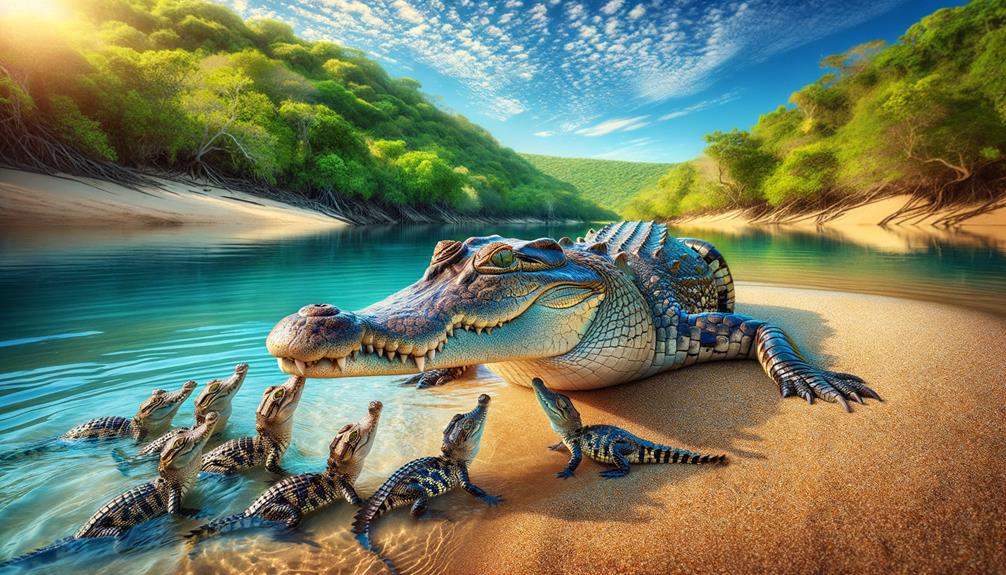
After the vigilant egg guarding phase, many reptiles exhibit remarkable behaviors to assist their hatchlings as they emerge into the world, ensuring their survival during the vulnerable early stages of life. Crocodilians are exemplary in their parental investment. Following egg deposition and egg incubation within a carefully constructed nest mound, crocodilian mothers remain near the nest for up to three months. This proximity allows them to respond to vocalizations from their hatchlings, signaling their readiness to enter the world.
Upon hearing these vocal cues, the mother carefully excavates the egg chamber and aids the hatchlings' escape from the nest mound. The assistance continues as she gently carries her young to the water, providing an immediate advantage in their new aquatic environment. Crocodilian parents, both male and female, exhibit the following behaviors:
They protect the nest mound from predators and environmental threats.
They excavate the egg chamber upon vocalization from the hatchlings.
They transport hatchlings to water, ensuring a smooth movement to their primary habitat.
They allow their young to use their bodies as basking platforms, which offers warmth and protection.
This profound parental investment highlights the significance of body contact and vocal communication in crocodilian species, which greatly enhances hatchling survival rates.
Live-Bearing Protection
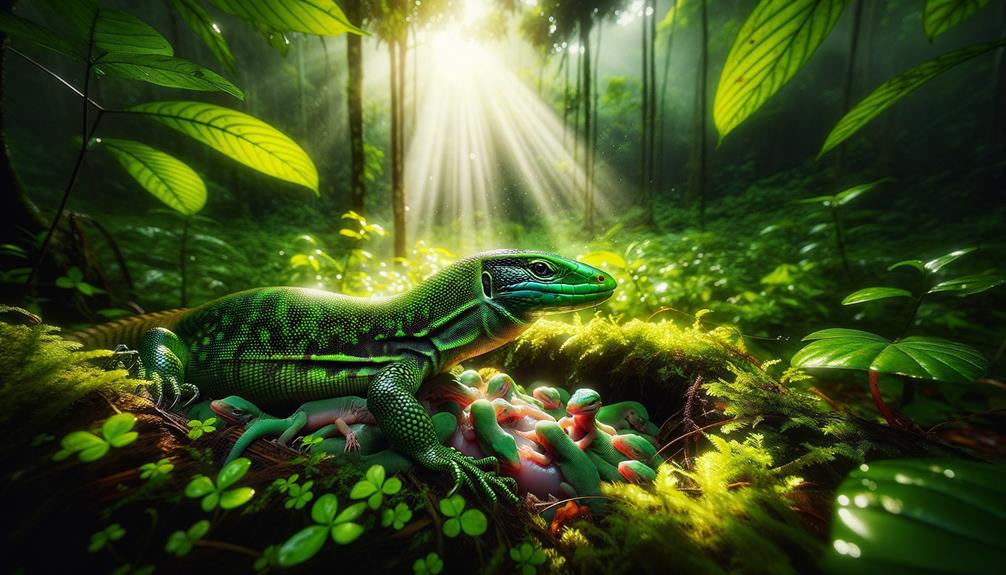
Live-bearing in squamates is a remarkable adaptation that enhances offspring survival through direct protection and nourishment. In these species, placental development varies, allowing for efficient gas exchange and nutrient transfer between the mother and developing embryos.
The birth process in squamates is similar to that of mammals, with embryos encased in unruptured amniotic membranes. The hatchlings must break free, a process aided by an egg tooth that helps them cut through the membranes. This adaptation bridges the gap between egg-laying and live-bearing species, ensuring the successful emergence of the young.
In species like turtles, crocodiles, and tuatara, a horny caruncle serves a similar purpose, helping hatchlings slice open the eggshell. These mechanisms demonstrate the evolutionary ingenuity of squamates, balancing traditional egg-laying traits with new strategies for live-bearing.
The interplay between live-bearing and these specialized structures showcases a sophisticated approach to offspring protection, highlighting the remarkable flexibility within the reptilian lineage. This strategy undoubtedly provides significant survival advantages to the young, preparing them for the world.
Evolutionary Adaptations
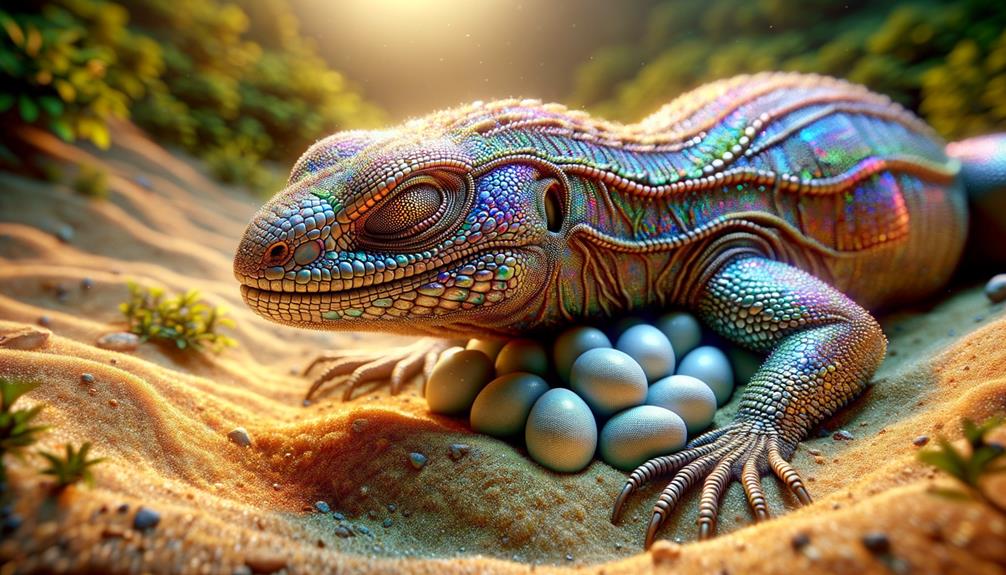
In examining the intricate live-bearing mechanisms of squamates, we gain a deeper appreciation for the diverse evolutionary adaptations that reptiles have developed to maximize offspring survival through varied parental care strategies. These adaptations reflect an impressive array of responses to environmental pressures and reproductive challenges.
- Viviparity: This significant trait involves females giving birth to live young instead of laying eggs, providing increased protection and nourishment through pregnancy and placental development.
- Temperature-dependent sex determination: In many species, the environmental temperature during egg incubation determines the sex of the offspring. This allows reptiles to adjust sex ratios in response to ecological conditions.
- Nesting behaviors: Different species exhibit unique nesting strategies. For instance, crocodilians build elaborate mounds for ideal egg incubation, while some monitor lizards use termite mounds to regulate temperature and humidity.
- Clutch and litter sizes: Smaller reptiles tend to produce fewer offspring, whereas larger species can have considerably larger clutches. This variation is an adaptive response to environmental pressures and resource availability.
These evolutionary adaptations highlight the intricate mechanisms by which reptiles have refined their parental care. By understanding these strategies, we appreciate the sophisticated balance between reproductive investment and offspring survival, reflecting a deep evolutionary wisdom embedded within these resilient species.
Frequently Asked Questions
What Is the Most Common Behavioral Problem in Reptiles?
Aggression is a common issue in reptiles, often stemming from territorial disputes or competition for resources. In captivity, poor living conditions like overcrowding can make these aggressive tendencies worse, leading to biting incidents.
Which Group of Reptiles Show Some Level of Parental Care?
Crocodilians take parental care to the next level, with females guarding and caring for their young. Some skinks and pythons go the extra mile to protect their eggs, while king cobras build nests to keep their eggs safe. Sea turtles are meticulous about maintaining ideal incubation temperatures, showcasing a range of parental behaviors in the reptile world.
Do Lizards Exhibit Parental Care?
Lizards do exhibit parental care. Certain species take steps to protect their young, such as coiling around their eggs, sharing nesting sites, and even taking action to prevent dehydration and remove harmful microorganisms, all of which help ensure their offspring's survival.
Do Reptiles Take Care of Their Babies?
Reptiles showcase a remarkable range of parental care behaviors. At one end, crocodilians fiercely protect their young, while at the other, many reptiles abandon their eggs immediately, leaving their offspring to fend for themselves. This striking contrast highlights the diverse strategies reptiles employ to invest in their offspring.


